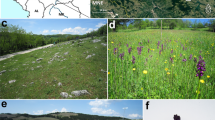Abstract.
The accumulation of elements in three dominant plant species, Jatropha curcas, Dodonea viscosa and Cassia auriculata, and their associated soils were studied. Multi-element analysis of these samples was carried out and the biological absorption coefficient (BAC) was calculated. Large amounts of B, Ba, Mn, Sr and Zn are found in the vegetation of the plant species under study. In their associated soils, large concentrations of Al, Fe and Be were also found. The BAC is the ratio of the concentration of an element in plant ash to that of its substrate. The results show the presence and/or absence of some elements in plants and soils, which can be explained on the basis of biogeochemical cycling of elements. Further, BAC is used to characterise the absorption of chemical elements by plants from their substrate.
Similar content being viewed by others
Author information
Authors and Affiliations
Additional information
Electronic Publication
Rights and permissions
About this article
Cite this article
Nagaraju, .A., Karimulla, .S. Accumulation of elements in plants and soils in and around Nellore mica belt, Andhra Pradesh, India – a biogeochemical study. Env Geol 41, 852–860 (2002). https://doi.org/10.1007/s00254-001-0465-z
Received:
Accepted:
Issue Date:
DOI: https://doi.org/10.1007/s00254-001-0465-z




